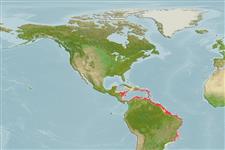Environment: milieu / climate zone / depth range / distribution range
Ökologie
seewasser; brackwasser demersal; tiefenbereich 1 - 60 m (Ref. 9626). Tropical; 21°N - 26°S, 90°W - 34°W
Western Atlantic: Antilles and Costa Rica to Rio de Janeiro, Brazil. Also Honduras (Ref. 26938).
Length at first maturity / Size / Gewicht / Alter
Maturity: Lm 11.1 range ? - ? cm
Max length : 31.0 cm TL Männchen/unbestimmt; (Ref. 5217); common length : 20.0 cm TL Männchen/unbestimmt; (Ref. 3702); max. veröff. Gewicht: 500.00 g (Ref. 5217)
Rückenflossenstacheln (insgesamt): 11; Rückenflossenweichstrahlen (insgesamt): 24-26; Afterflossenstacheln 2; Afterflossenweichstrahlen: 7 - 8. Colour silvery grey, darker above. A dark spot at bases of pectoral fins. Pelvic and anal fins often yellowish. A medium-sized to small fish, short and robust. Mouth very large, strongly oblique, lower jaw projecting. Teeth very small and sharp, set in 1 or 2 rows along edges of jaws. Chin without barbels, but with 4 minute pores. Snout with 5 marginal pores, no rostral pores. Gas bladder with a pair of small, horn-like anterior appendages. Sagitta (large earstone) thick and short (Ref 51721).
Inhabits coastal waters, usually found over mud and sandy mud bottoms (Ref. 3702). Also in estuaries (Ref. 3702). Important food fish.
Life cycle and mating behavior
Geschlechtsreife | Fortpflanzung | Ablaichen | Eier | Fecundity | Larven
Cervigón, F., 1993. Los peces marinos de Venezuela. Volume 2. Fundación Científica Los Roques, Caracas,Venezuela. 497 p. (Ref. 9626)
IUCN Rote Liste Status (Ref. 130435)
Bedrohung für Menschen
Harmless
Nutzung durch Menschen
Fischereien: kommerziell; Köder: occasionally
Mehr Information
ReferenzenAquakulturAquakultur ProfilZuchtlinienGenetikElectrophoresesVererbbarkeitKrankheitenVerarbeitungNutrientsMass conversion
PartnerBilderStamps, Coins Misc.LauteCiguateraGeschwindigkeitSchwimmstilKiemenoberflächeOtolithsGehirngrößeSehfähigkeit
Tools
Zusatzinformationen
Download XML
Internet Quellen
Estimates based on models
Preferred temperature (Ref.
123201): 24.7 - 28.1, mean 27.5 °C (based on 186 cells).
Phylogenetic diversity index (Ref.
82804): PD
50 = 0.5156 [Uniqueness, from 0.5 = low to 2.0 = high].
Bayesian length-weight: a=0.00871 (0.00800 - 0.00948), b=3.09 (3.07 - 3.11), in cm total length, based on LWR estimates for this species (Ref.
93245).
Trophic level (Ref.
69278): 3.5 ±0.6 se; based on diet studies.
Generation time: 2.0 ( na - na) years. Estimated as median ln(3)/K based on 1
growth studies.
Widerstandsfähigkeit (Ref.
120179): hoch, Verdopplung der Population dauert weniger als 15 Monate. (Preliminary K or Fecundity.).
Fishing Vulnerability (Ref.
59153): Low vulnerability (25 of 100).
Nutrients (Ref.
124155): Calcium = 177 [103, 341] mg/100g; Iron = 1.15 [0.62, 2.00] mg/100g; Protein = 19.1 [18.0, 20.1] %; Omega3 = 0.248 [0.133, 0.412] g/100g; Selenium = 49.5 [27.5, 92.7] μg/100g; VitaminA = 20.4 [8.2, 54.9] μg/100g; Zinc = 1.45 [1.06, 2.05] mg/100g (wet weight);
